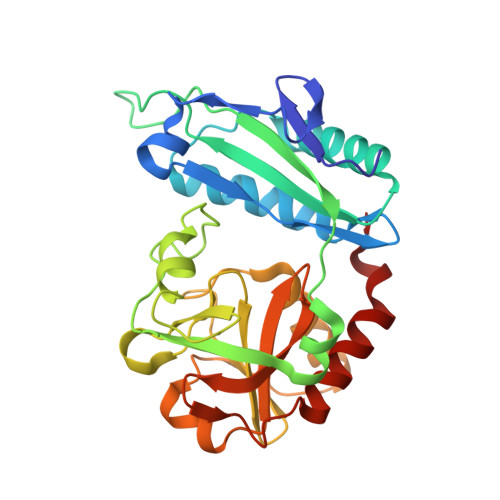In search for structural targets for engineering d-amino acid transaminase: modulation of pH optimum and substrate specificity.
Shilova, S.A., Matyuta, I.O., Khrenova, M.G., Nikolaeva, A.Y., Klyachko, N.L., Minyaev, M.E., Khomutov, A.R., Boyko, K.M., Popov, V.O., Bezsudnova, E.Y.(2023) Biochem J 480: 1267-1284
- PubMed: 37548495
- DOI: https://doi.org/10.1042/BCJ20230233
- Primary Citation of Related Structures:
8AYJ, 8ONJ, 8ONL, 8ONN - PubMed Abstract:
The development of biocatalysts requires reorganization of the enzyme's active site to facilitate the productive binding of the target substrate and improve turnover number at desired conditions. Pyridoxal-5'-phosphate (PLP) - dependent transaminases are highly efficient biocatalysts for asymmetric amination of ketones and keto acids. However, transaminases, being stereoselective enzymes, have a narrow substrate specificity due to the ordered structure of the active site and work only in neutral-alkaline media. Here, we investigated the d-amino acid transaminase from Aminobacterium colombiense, with the active site organized differently from that of the canonical d-amino acid transaminase from Bacillus sp. YM-1. Using a combination of site-directed mutagenesis, kinetic analysis, molecular modeling, and structural analysis we determined the active site residues responsible for substrate binding, substrate differentiation, thermostability of a functional dimer, and affecting the pH optimum. We demonstrated that the high specificity toward d-glutamate/α-ketoglutarate is due to the interactions of a γ-carboxylate group with K237 residue, while binding of other substrates stems from the effectiveness of their accommodation in the active site optimized for d-glutamate/α-ketoglutarate binding. Furthermore, we showed that the K237A substitution shifts the catalytic activity optimum to acidic pH. Our findings are useful for achieving target substrate specificity and demonstrate the potential for developing and optimizing transaminases for various applications.
Organizational Affiliation:
Bach Institute of Biochemistry, Research Centre of Biotechnology of the Russian Academy of Sciences, Moscow, Russia.
















